| Srl | Item |
| 1 |
ID:
165753
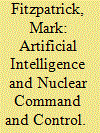

|
|
|
|
|
| Summary/Abstract |
An IISS tabletop exercise showed how an AI arms race could reduce strategic stability as nuclear-weapons states become more reliant on artificial intelligence.
|
|
|
|
|
|
|
|
|
|
|
|
|
|
|
|
| 2 |
ID:
102234
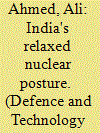

|
|
|
| 3 |
ID:
170742
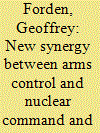

|
|
|
|
|
| Summary/Abstract |
There are renewed worries that the U.S. nuclear command, control, and communications system (NC3) might be attacked with cyberweapons, potentially triggering a war.1 These concerns have been present since at least 1972 when the Air Force Computer Security Technology Planning Study Panel found that the “current systems provide no protection [against] a malicious user
|
|
|
|
|
|
|
|
|
|
|
|
|
|
|
|
| 4 |
ID:
079770
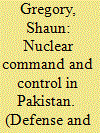

|
|
|
| 5 |
ID:
168934
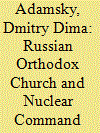

|
|
|
|
|
| Summary/Abstract |
The Russian Orthodox Church plays an immense role in current Russian national security policy. The intertwining of the church and the strategic community is nowhere more visible than in the nuclear-weapons complex, where the priesthood has penetrated all levels of command, been involved in operational activities, and positioned itself as a provider of meanings for, and guardian of, the state’s nuclear potential. The first work to highlight the phenomenon of the Russian church-nuclear nexus, this article focuses on the ecclesiastical impact on Russian nuclear command and control. The findings suggest that it is not inconceivable that the Russian military clergy—like the Soviet political officers and contrary to chaplains worldwide—might become future participants in decision making on matters of national security, and that de facto there might be two parallel chains of command authority emerging in Russia, with potential tensions between them. The article outlines the causes of this overlooked singularity and its implications for the theory and practice of international security.
|
|
|
|
|
|
|
|
|
|
|
|
|
|
|
|
| 6 |
ID:
144765
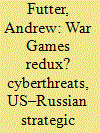

|
|
|
|
|
| Summary/Abstract |
Some 30 years since the release of the Hollywood blockbuster War Games, the possibility that hackers might break into nuclear command and control facilities, compromise early warning or firing systems, or even cause the launch of a nuclear weapon has become disturbingly real. While this challenge will impact all nuclear-armed states, it appears particularly acute for the USA and Russia given their large, diverse, and highly alerted nuclear forces. The fact that east–west relations have deteriorated to a nadir perhaps not seen since the 1980s, strategic instability has increased – particularly in the wake of the Ukraine and now Syria crises – and that the nuclear arms reductions agenda appears to have reached a standstill makes this challenge particularly pressing. In this discouraging milieu, new cyberthreats are both exacerbating the already strained US–Russia strategic balance – particularly the perceived safety and security of nuclear forces – and at the same time creating new vulnerabilities and problems that might be exploited by a third party. Taken together, these dynamics add another major complication for current arms control agreements and possible future nuclear cuts, and also seem likely to increase the possibility of accidents, miscalculation, and potential unauthorised nuclear use, especially given the large number of nuclear weapons that remain on “hair-trigger” alert.
|
|
|
|
|
|
|
|
|
|
|
|
|
|
|
|